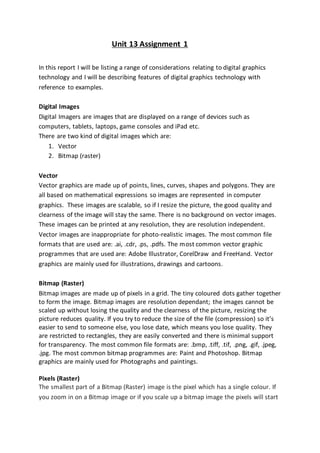
Unit 13 assignment 1 report
- 1. Unit 13 Assignment 1 In this report I will be listing a range of considerations relating to digital graphics technology and I will be describing features of digital graphics technology with reference to examples. Digital Images Digital Imagers are images that are displayed on a range of devices such as computers, tablets, laptops, game consoles and iPad etc. There are two kind of digital images which are: 1. Vector 2. Bitmap (raster) Vector Vector graphics are made up of points, lines, curves, shapes and polygons. They are all based on mathematical expressions so images are represented in computer graphics. These images are scalable, so if I resize the picture, the good quality and clearness of the image will stay the same. There is no background on vector images. These images can be printed at any resolution, they are resolution independent. Vector images are inappropriate for photo-realistic images. The most common file formats that are used are: .ai, .cdr, .ps, .pdfs. The most common vector graphic programmes that are used are: Adobe Illustrator, CorelDraw and FreeHand. Vector graphics are mainly used for illustrations, drawings and cartoons. Bitmap (Raster) Bitmap images are made up of pixels in a grid. The tiny coloured dots gather together to form the image. Bitmap images are resolution dependant; the images cannot be scaled up without losing the quality and the clearness of the picture, resizing the picture reduces quality. If you try to reduce the size of the file (compression) so it’s easier to send to someone else, you lose date, which means you lose quality. They are restricted to rectangles, they are easily converted and there is minimal support for transparency. The most common file formats are: .bmp, .tiff, .tif, .png, .gif, .jpeg, .jpg. The most common bitmap programmes are: Paint and Photoshop. Bitmap graphics are mainly used for Photographs and paintings. Pixels (Raster) The smallest part of a Bitmap (Raster) image is the pixel which has a single colour. If you zoom in on a Bitmap image or if you scale up a bitmap image the pixels will start
- 2. to become visible. Each pixel on a screen emits red, blue and green light. By changing the levels of each of these colours, the screen is able to produce any possible colour. Image Capturing Image capturing is when an image has been scanned after being drawn. Here is an example of what Vector and Bitmap images would look like if they were resized: In these images you can see that they are showing what bitmap and vector images actually look like. The pictures and fonts have been resized so you can see the difference between bitmap and vector images. The vector images have the same clarity as the previous image. The picture is clear, not blurry and very easy to read. However the bitmap images have changed, they have become blurry, pixelated and really hard to read. Output An output is when an image is outputted. When you output a picture it often determines the kind of image it needs to be. Screen: using pixels to display an image. Uses the RGB colour pallet (Green, Red and Blue) Print: printing uses the CYMK pallet (Cyan, Yellow, Magenta, and Black) Outputs: prints (paper), screen & online. Storage Storage determines the size of the storage, so how big or small it is and if there is space for any other files.
- 3. Naming conventions: It is extremely important to save the work with appropriate names. Names that are suitable. The reason it is important is because it’s much easier for you to find your work. You need to back up your work on a USB or a cloud. If you don’t, and you lose your work then you will not be able to get it back. However if it’s backed up, you still have your work. Asset management: It’s best to keep your work organized at all times so you don’t get confused or anything, and you know exactly where everything is. Make sure the work is put into the correct folder because it’s much easier to access. File size: The larger the file, the harder it becomes to email. It takes much longer to download, and it takes up a lot of space in the computers memory.